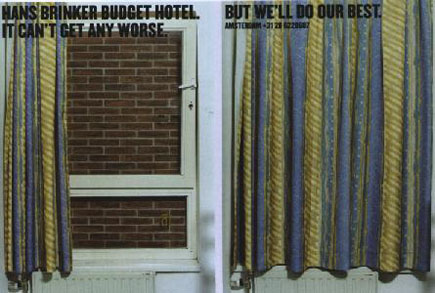First of all I’d like to apologise for the
tenuous links in the forthcoming post, of which there are at least 2. They are
all in a good cause I assure you, as if you haven’t yet seen the particular range
of work I will later mention, I think you’ll be suitably amused enough to overlook my
laziness.
Disclaimer over and done with, I’ll get on with the shamelessness. Here it goes.
I’m off to Copenhagen! Hurrah! Very
exciting for me, but "why should I care?" I hear you cry. Well, having purchased my
extremely cheap Ryanair flights I am now faced with choosing from a
particularly "nice" range of hostels. Do I want to pay £10 a night more to share
with 5 people, or go cheaper and sleep in the same room as a whole 9 other
people. Hmm, decisions, decisions... If only I was back in Amsterdam (tenuous link
#1 : very vague geographical vicinity) where the only choice for broke
20-something backpackers is the Hans Brinker Budget Hotel (tenuous link #2 :
accommodation type); and though it calls itself a hotel, it is most definitely a
hostel. The same hostel my mum stayed in, in the 70s...
 What sets this hostel apart from the reams
of others in Amsterdam is their unique advertising. For 15+ years ad agency
Kessels Kramer has been creating some incredibly memorable and hilariously
honest posters, books and promotions for Hans Brinker, which in 2009 they
chronicled in 'The Worst Hotel in the World'.
What sets this hostel apart from the reams
of others in Amsterdam is their unique advertising. For 15+ years ad agency
Kessels Kramer has been creating some incredibly memorable and hilariously
honest posters, books and promotions for Hans Brinker, which in 2009 they
chronicled in 'The Worst Hotel in the World'.
 What sets this hostel apart from the reams
of others in Amsterdam is their unique advertising. For 15+ years ad agency
Kessels Kramer has been creating some incredibly memorable and hilariously
honest posters, books and promotions for Hans Brinker, which in 2009 they
chronicled in 'The Worst Hotel in the World'.
What sets this hostel apart from the reams
of others in Amsterdam is their unique advertising. For 15+ years ad agency
Kessels Kramer has been creating some incredibly memorable and hilariously
honest posters, books and promotions for Hans Brinker, which in 2009 they
chronicled in 'The Worst Hotel in the World'.
The crux of each and every campaign is the
simple, absolute rubbishness of the accommodation.
The website begins:
“The Hans Brinker Budget Hotel has been proudly disappointing travelers for forty years. Boasting levels of comfort comparable to a minimum-security prison.”
A bold brand strategy but one that has paid off. It’s an incredible lesson in using humour and honesty to create brand awareness, and although they won’t be attracting middle class families to their doors anytime soon they have guaranteed their place as the number 1 stop for budget travelers to Amsterdam.
Of the portfolio of work produced by
Kessels Kramer my favourite by far has been the “Accidentally Eco-Friendly” campaign
from 2007. Check out the video:
…and the posters:
For a good laugh visit the website. You may
even find yourself weirdly curious to check out the place. After all, it can’t actually
be that bad, can it?








